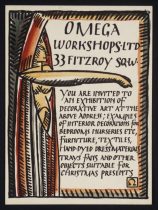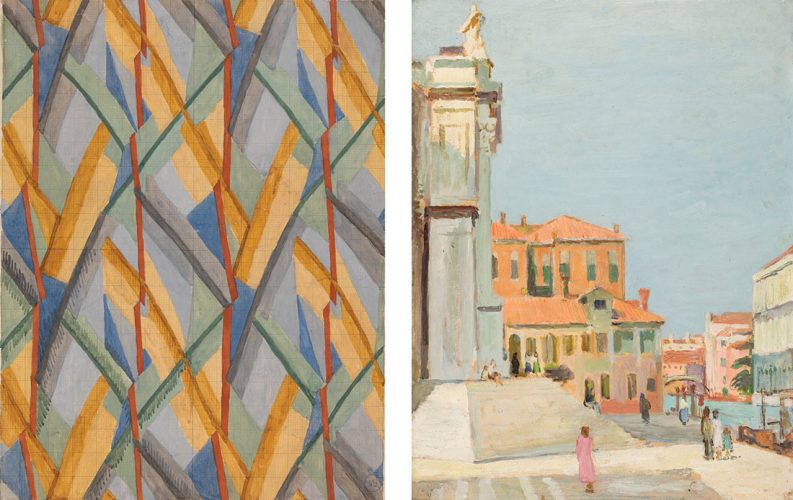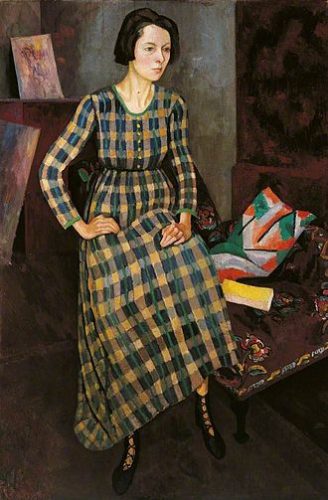The Omega Workshops Ltd. was founded by members of the Bloomsbury Group, Roger Fry, Vanessa Bell, and Duncan Grant in July 1913 “with the intention of providing graphic expression to the essence of the Bloomsbury ethos.” Fry believed that artists could design, produce, and sell their own decorated crafts and household items to earn additional income. In addition to offering a wide range of individual products, such as painted furniture, painted murals, mosaics, stained glass, and textiles, Omega Workshops offered interior design themes for various living spaces. A commission was given to the Omega to decorate a room for the 1913 Ideal Home Exhibition, and an illustrated catalogue, including text written by Fry, was published in autumn 1914.
The artist, novelist, and close friend of Ezra Pound and T.S. Eliot, Wyndham Lewis was initially part of the operation. Lewis, however, split off at an early stage, taking with him several other participants to start the rival decorative workshop Rebel Art Centre after accusing Fry of misappropriating the commission for the Ideal Home Exhibition. In October 1913, Wyndham Lewis, Frederick Etchells, Edward Wadsworth, and Cuthbert Hamilton announced their resignation from Omega in a letter to its shareholders and patrons, which contained accusations particularly against Fry, criticizing the workshop’s products and ideology.

In the autumn of 1913 Fry started designing and making pottery. . . . The range of products continued to increase throughout Omega Workshops’ six-year existence, and in April 1915 Vanessa Bell began using Omega fabrics in dress design, after which dressmaking became a successful part of the business.
Omega closed in 1919, after a clearance sale, and was officially liquidated on 24 July 1920. A series of poor financial decisions and internal conflicts all contributed to its decline. At the time of its closure, Fry was the only remaining original member working regularly at the workshop. Despite this, Omega became influential in interior design in the 1920s.
— “Omega Workshops.” Wikipedia, 25 June 2017, https://en.wikipedia.org/wiki/Omega_Workshops. Accessed 28 June 2017.

“Founded by Roger Fry, the Omega Workshops opened to the public in 1913, bringing the abstract forms and bold colours of modern art into the designs for furniture, textiles and other household accessories . . . Fry was not concerned with social reform or protesting against contemporary machine manufacture, but wanted to remove what he saw as the false division between the fine and decorative arts. He wanted to see some of the main ideas of post-impressionism, such as bright colours and bold, simplified forms, applied to design. . . . Fry also wanted to help his artist friends by providing them with the chance to make a living designing and decorating furniture, textiles and other household accessories, alongside their artistic careers. Fry felt that objects and furniture should be bought and valued for their beauty rather than because of the reputation of the artist, so he insisted that all work be produced anonymously. Designs were unsigned and marked only with the symbol Ω, the Greek letter Omega. Omega is the last letter of the Greek alphabet, and in the late nineteenth century it was used to mean the ‘last word’ on a subject.
“Despite Roger Fry’s best efforts, Omega struggled to survive financially and closed in 1919 just six years after it opened its doors. In June 1919 Fry wrote in a letter to his friend and supporter Michael Saddler: ‘The utter indifference…of the public to what we have attempted has bought Omega to disaster’. A combination of inefficient techniques, expensive materials, and a lack of orders, as well as internal wranglings forced Omega to close in 1919. . . . By this time Fry was the only original member still working regularly at Fitzroy Square as Vanessa Bell and Duncan Grant were now living at Charleston, and many of the other artists had moved on. In the letter he wrote to Sir Michael Saddler in 1919 he revealed just how much the Workshops had cost him financially:
I kept it alive by doles out of my own pocket during the war believing that some kind of revival might take place when it was over. Now I have come to the end of my tether. I have lost £2000 and five years of gratuitous hard work & I can’t waste more on a country that regards the attempt to create as a kind of Bolshevism. Anyhow art in England must get on as best it can without me…”— “Omega Workshops.” Tate, n.d., http://www.tate.org.uk/learn/online-resources/bloomsbury-group/omega-workshops. Accessed 28 June 2017.

“The Omega Workshops Ltd opened to the public in July 1913, its showrooms and studios in a house at 33 Fitzroy Square. Fry was its driving force and director; Grant and Bell were shareholding co-directors. Along with these three, the artists principally identified with the opening displays of furniture, wall decorations and textiles were Wyndham Lewis, Frederick and Jessie Etchells, Edward Wadsworth, Henri Doucet . . . Paul Nash, Nina Hamnett and Henri Gaudier-Brzeska. All works were sold anonymously, designs for future items were centrally pooled and artists were paid so much per day (usually seven shillings and sixpence). There was a business manager, accountant, caretaker and a changing cast of assistants in the salesroom and studios. Outside craftsmen and manufacturers were employed for printed fabrics, carpets, furniture and, later, pottery. Whole interiors were undertaken and Omega wares were prominent in various fine and applied art exhibitions in London. There was good press coverage, most of it favourable, and eventually the Omega sold work abroad. During the war, concerts, lectures and ‘evenings’ were organized, as well as theatrical performances, and its activities included one-artist shows . . . [such as] Vanessa Bell’s first solo exhibition (1916). . .” (137).
“The years 1913-14 saw the Omega at its most innovative: outstanding are its abstract fabrics and carpets, simple unadorned furniture and pottery that was distinctly ahead of its time in Britain. An artist’s personal spontaneity of expression formed the keynote within the homogeneous sensibility of the Omega style; good craftsmanship, at least in the early days, was encouraged; professionalism went hand in hand with informality; it was revolutionary yet amenable. . . . After the outbreak of war in 1914 it became increasingly difficult to attract new artists, sales and commissions fluctuated and Fry’s stalwart collaborators, Bell and Grant, were in rural retreat [at Charleston, in Grant’s case, doing agricultural work in lieu of conscription]. . . . By 1919 Fry was eager to concentrate on his own painting and writing and the Omega was losing money; in June-July that year a clearance sale was held and the company went into voluntary liquidation a year later” (138).
— Shone, Richard. The Art of Bloomsbury: Roger Fry, Vanessa Bell and Duncan Grant. Princeton UP, 1999.
“A plan was sketched in talk. A company was to be formed; a workshop was to be started. The young artists were to make chairs and tables, carpets and pots that people liked to look at; that they liked to make. Thus they were to earn a living; thus they would be free to paint pictures, as poets wrote poetry, for pleasure not for money. Thus they would assert the freedom of art ‘from all trammels and tyrannies’. . . . He knew by this time the drudgery and the difficulty of putting such schemes into execution. He had first-hand knowledge both of artists and business men and of the abuse that is the reward of one who tries to bring them together. But – ‘all the people in this new movement are alive and whatever they do has life’” (189).
“In July 1913 the Omega workshops in Fitzroy Square were opened. . . . The house in which Roger Fry set up his workshop is there to-day – a house with a past of its own, a Georgian past, a Victorian past. . . . But now the Georgian and the Victorian ghosts were routed. Two Post-Impressionist Titans were mounted over the doorway; and inside everything was bustle and confusion. There were bright chintzes designed by the young artists; there were painted tables and painted chairs; and there was Roger Fry himself escorting now Lady So-and-so, now a business man from Birmingham, round the rooms and doing his best to persuade them to buy” (190).
“It was, as he said ‘very exciting’. The public was eager to buy; and the artists were eager to work. He was surprised by the excellence of their work. ‘The artists have a tremendous lot of invention and a new feeling for colour and proportion that astonish me’, he told Lowes Dickinson. ‘My fearful problem is that to harness the forces I’ve got and to get the best out of them practically and it’s the deuce to do.’ The truth of that last statement was soon to be proved” (191). [Here Woolf quotes from a circular and the letter sent by Wyndham Lewis and the others accusing Fry and withdrawing from the Omega.]

“But he had much more important matters to attend to than storms in tea-cups. The ‘fearful problem’ presented by the Omega was very real. It showed signs of immediately becoming a great success. Orders were coming in. The public was amused and interested. The papers devoted a great deal of space to the new venture. Interviewers were sent to Fitzroy Square, and one of them has recorded his impressions of the Omega in those early days. Mr Fry, he says, took him around and he asked Mr Fry to explain his intentions. ‘It is time’, said Mr Fry, ‘that the spirit of fun was introduced into furniture and into fabrics. We have suffered too long from the dull and the stupidly serious.’ He took up a wool work cushion. ‘What do you think that represents?’ said Mr Fry. ‘A landscape?’ the interviewer hazarded. Mr Fry laughed. ‘It is a cat lying on a cabbage playing with a butterfly’, he said. . . . The interviewer looked at last saw the butterfly though he failed to see the cat. Then Mr Fry showed him a chair. He said it was ‘a conversational chair’, a witty chair; . . . its legs were bright-blue and yellow, and brilliant bands of intense blue and green were worked around a black seat.” Certainly it was much more amusing than an ordinary chair. . . . Then he brought out a screen upon which there was a picture of a circus. The interviewer was puzzled by the long waists, bulging necks and short legs of the figures. ‘But how much wit there is in those figures’, said Mr Fry. ‘Art is significant deformity.’ The interviewer was interested. Upstairs they went to the great white work-room, where one artists was at work upon a ceiling, another was painting what appeared to be ‘a very large raccoon with very flexible joints’ for the walls of a nursery. Then down again to the show-room where the journalist was made to look at chintzes, cushions, lamp-shades, garden tables and also ‘a radiantly coloured dress of gossamery silk’ designed by a French artist. Mr Fry was tackling the subject of women’s dress. . . . It was very beautiful, the interviewer agreed, but would English women ever have the courage to wear it? ‘Oh,’ said Mr Fry, ‘people will have to be educated . . .’ So at last the interviewer took himself off, prophesying that posterity would hold the Omega in honour because ‘it had brought beauty and careful workmanship into the common things of life’” (195).
“The Omega too had survived the war, but in a badly crippled condition. A fresh spurt of business came, or course, with the peace; but then three of the staff went down with influenza; the auditors complained of the unbusinesslike book-keeping, and Roger Fry had to pay certain debts out of his own pocket. At last, when it came to selling two chairs for four pounds ‘after being abject the whole afternoon’, the struggle seemed no longer worth the effort. By March 1919 he determined to make an end of it; and in June of that year he presided over a sale of the goods at the Omega workshops (216) . . . So the Omega workshops closed down. The shades of the Post-Impressionists have gone to join the other shades; no trace of them is now to be seen in Fitzroy Square . . . and the rooms have other occupants. But some of the things he made still remain – a painted table; a witty chair; a dinner service; a bowl or two of that turquoise blue the man from the British Museum so much admired. And if by chance one of those broad deep plates is broken, or an accident befalls a blue dish, all the shops in London may be searched in vain for its fellow” (218).
— Woolf, Virginia. Roger Fry, A Biography. Harcourt Brace Jovanovich, 1940.